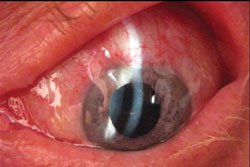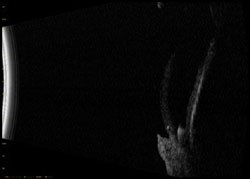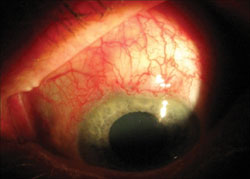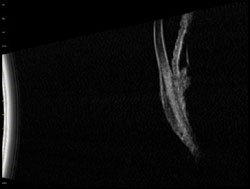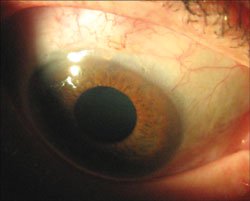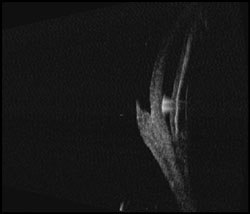Stainless steel micro-drainage device may be helpful in severe refractory glaucoma cases
The device has shown stable, long-term IOP-lowering results, according to a clinician.
A new stainless steel wire micro-drainage device is showing stable, long-term IOP-lowering results in eyes with severe refractory open-angle glaucoma, according to one surgeon.
The device has been patented in Russia.
“It is a simple loop-shaped device, made from 250-µm surgical-grade stainless steel wire, bent on a 0.5-mm thick and 2.5-mm wide metallic spatula,” Vinod Kumar, MD, said at a recent meeting.
Implantation procedure
 Vinod Kumar |
According to Dr. Kumar, the device is implanted with a simple procedure: A fornix-based conjunctival flap is created. Approximately 1.5 mm to 2 mm away from the limbus, a 2-mm × 1-mm scleral groove is ablated down to 98% of the scleral thickness using a plasma blade, and from there a scleral tunnel reaching into the anterior chamber is created with a diamond knife.
“At this point the device is inserted,” Dr. Kumar said. “Being loop-shaped, it is easily fixated to the sclera at one end, using a 10-0 nylon suture. Finally, the conjunctiva is closed and sutured to the limbus.”
The procedure is simple to perform, he noted. The device is easily inserted and fixated. It provides controlled filtration of the aqueous humor, with no sudden gush of fluid.
“In all our cases, we had no loss of the anterior chamber. Effective, controlled filtration was achieved. No hemorrhagic choroidal effusion occurred intraoperatively,” he said.
Study results
A total of 42 eyes were implanted with the device. Patients’ ages ranged between 55 years and 79 years. Minimum follow-up was 1 year.
“All these cases were admitted for evisceration for painful terminal glaucoma. Intraocular pressure varied from 27 mm Hg to 42 mm Hg. All patients were on medications, two drops a day at least. All of them experienced severe pain,” Dr. Kumar said.
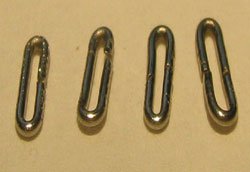 Technique of stainless steel wire micro-drainage device (SSWMDD) preparation: SSWMDD was made from surgical grade stainless steel wire by winding it once on a 2.5 mm wide and 0.5 mm thick metallic spatula. SSWMDD are sterilized by autoclaving. |
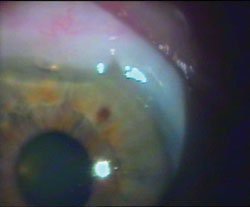 The stainless steel wire micro-drainage device in the anterior chamber – gonioscopic view. |
|
|
|
|
Outlook of the eyeball after 3 months
following implantation of device with creation of fornix-based conjunctival
flap. |
|
|
|
|
|
The eyeball after 6 months following simple
procedure to implant device. |
|
|
|
|
|
The eyeball after 1 year, which showed good
results, with cataract surgery performed in only 7% of cases and one case
requiring repeat surgery and insertion of another device. |
|
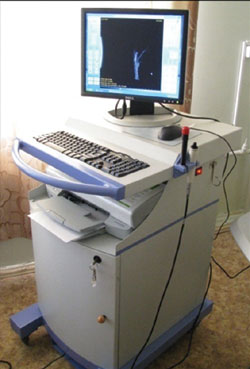 Marvel B-scan with UBM (Appasamy Medical Equipment Pvt. Ltd., India) was used at 3 months to determine positioning of device. Images: Kumar V |
As a result of surgery, 41 eyes were saved. Those eyes became functional again and gradually regained normal appearance. All patients reported effective relief from pain. IOP control was achieved without medication in 81% of the cases and with medication in 97.6% of patients.
Mean IOP decrease was 18 mm Hg (56%).
“We encountered few, transient postoperative complications,” Dr. Kumar said. “In the early postoperative period, a shallow anterior chamber was found in 11 eyes (26%), due to choroidal effusion. In two cases, the effusion dissolved spontaneously, and in nine cases, a sclerostomy was performed with positive results. No case of hypotony was observed during the follow-up. Within 1 year from surgery, cataract surgery was performed in three cases (7%), [and] one case (2.4%) required repeat surgery with insertion of another [stainless steel wire micro-drainage device].”
Gonioscopic views of the device after implantation showed that it was well-positioned and stable, far from the corneal endothelium and the iris surface. Ultrasound biomicroscopy images at 3 months showed proper positioning of the device, as well as stable, regular drainage and a regular filtration bleb.
“It is a simple procedure, minimally invasive, safe and effective in the long term,” Dr. Kumar said. – by Michela Cimberle

- Vinod Kumar, MD, can be reached at Department of Ophthalmology, Russian People’s Friendship University, Moscow, Russian Federation; +79164745086; email: vinod_kumar@mtu-net.ru or kumarvinod1955@gmail.com.
- Disclosure: Dr. Kumar and colleagues created the device in their department, but have no financial interest in the product.

